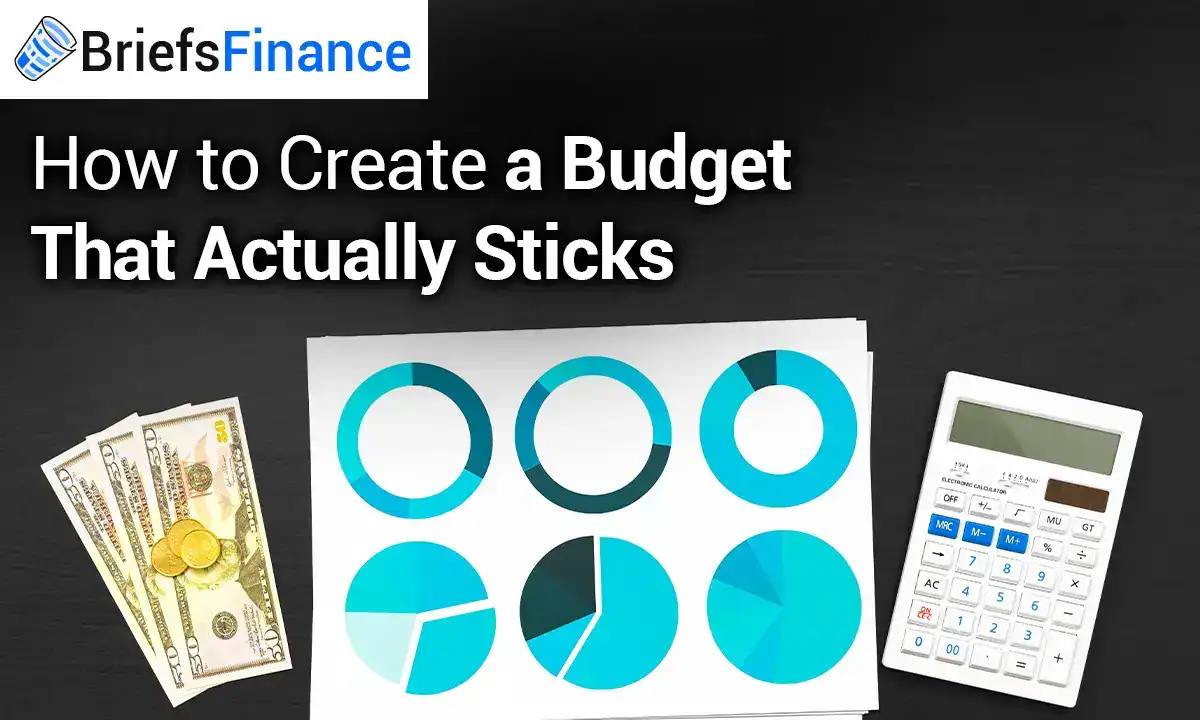Most budgets fail within the first month. Not because people lack discipline, but because the budget itself is unrealistic, overly complicated, or fights against human nature.
Why Most Budgets Fail
You've probably tried budgeting before. You downloaded an app, created categories, and promised yourself this time would be different.
Then you overspent on groceries. Forgot about your friend's birthday. Had an unexpected car repair. Within three weeks, you abandoned the whole thing.
Here's why that happens:
Budgets are too restrictive. Allocating exactly $400 for groceries and $50 for entertainment feels like a financial prison. One unplanned dinner out blows the budget and triggers the "screw it" response.
Budgets require too much effort. Logging every coffee purchase and categorizing every transaction takes mental energy most people don't have after work.
Budgets ignore irregular expenses. You budget for monthly bills but forget about car registration, annual subscriptions, holiday gifts, and other periodic costs.
Budgets fight human nature. Telling yourself "no spending" is like telling yourself "no thinking about elephants." Restriction creates desire.
A budget that sticks works with your psychology, not against it.
The Foundation: Track Before You Budget
Don't create a budget based on what you think you spend. Track what you actually spend.
The One-Month Tracking Challenge
Spend one month recording every expense without trying to change your behavior.
Use your bank and credit card statements. Every purchase gets categorized: housing, transportation, food, entertainment, subscriptions, shopping, etc.
This reveals your actual spending patterns, not your aspirational ones. You might think you spend $300 monthly on groceries but actually spend $550. You can't budget effectively without this truth.
What You'll Discover
Most people are shocked by three things:
Small purchases add up brutally. That $5 coffee five times weekly is $1,300 annually. The $15 lunch out three times weekly is $2,340 yearly.
Subscription creep is real. Netflix, Spotify, gym membership, Amazon Prime, gaming subscriptions, app subscriptions - you're probably spending $100-300 monthly on things you forgot you had.
Irregular expenses destroy budgets. Annual insurance payments, quarterly pest control, biannual car maintenance - these one-time costs wreck monthly budgets if you don't plan for them.
The 50/30/20 Budget Framework
Forget complicated spreadsheets with 47 categories. Start with three buckets.
50% Needs: Essential Expenses
Half your after-tax income covers necessities you can't avoid:
Housing: Rent/mortgage, property taxes, insurance, basic utilities Transportation: Car payment, gas, insurance, maintenance, or public transit Groceries: Food you cook at home Insurance: Health, life, disability (beyond what's covered above) Minimum debt payments: Student loans, credit cards, personal loans Essential utilities: Electric, water, internet, phone
These are true needs. You can't eliminate them without major life changes.
30% Wants: Discretionary Spending
Thirty percent goes to everything that makes life enjoyable but isn't essential:
Dining out: Restaurants, takeout, delivery, coffee shops Entertainment: Movies, concerts, hobbies, streaming services Shopping: Clothes, electronics, home décor Travel: Vacations, weekend trips, hotels Gym: Fitness classes, sports leagues Personal care: Haircuts, spa treatments beyond basics
These are wants. You could eliminate them if necessary, but life would be less fun.
20% Savings and Debt Payoff
Twenty percent builds your financial future:
Emergency fund: Until you reach 3-6 months of expenses Retirement: 401(k), IRA, or other retirement accounts Extra debt payments: Beyond minimums to eliminate debt faster Short-term savings: Down payment, car replacement, home repairs Investments: Brokerage accounts, index funds
This 20% is what separates people who build wealth from people who stay paycheck-to-paycheck.
Making the Math Work
If your after-tax monthly income is $5,000:
- Needs: $2,500 (housing $1,500, transportation $500, groceries $300, insurance $150, debt minimums $50)
- Wants: $1,500 (dining $400, entertainment $300, shopping $400, personal care $200, subscriptions $200)
- Savings: $1,000 (emergency fund $300, 401k $500, extra debt payment $200)
If your percentages don't align, you have three options: increase income, decrease needs, or decrease wants.
Budgeting Methods That Actually Work
Different approaches work for different people. Try these proven systems.
The Anti-Budget (Reverse Budgeting)
Pay yourself first, then spend whatever's left guilt-free.
How it works: Automate savings on payday. The amount going to savings, retirement, and debt payoff gets transferred automatically. Whatever remains in checking is yours to spend however you want.
This removes the need to track every purchase. As long as your checking account has money, you can spend it. When it's empty, you're done until next payday.
Best for: People who hate tracking expenses but are good at not overdrafting.
The Cash Envelope System
Use physical cash for variable spending categories.
How it works: Withdraw cash each month for groceries, dining out, entertainment, and shopping. Put cash into separate envelopes labeled by category. When an envelope is empty, you're done spending in that category.
The physical nature makes spending real. Handing over cash hurts more than swiping a card, naturally reducing spending.
Best for: People who overspend on cards and need a physical spending limit.
The Zero-Based Budget
Every dollar gets assigned a job before the month begins.
How it works: List your income. Subtract every expense, savings contribution, and debt payment until you reach zero. Every dollar has a purpose: bills, groceries, entertainment, savings, etc.
This creates intentionality. Money doesn't disappear into vague "spending." You deliberately allocate it.
Best for: People who like detailed planning and control.
The Spending Percentages Method
Simplify further than 50/30/20 with just two categories.
How it works: Automate fixed expenses and savings (70% of income). The remaining 30% is for everything else - groceries, gas, shopping, entertainment. Track this single number.
Best for: People who want extreme simplicity and hate categories.
The Power of Automation
Willpower is finite. Automation removes decisions that drain willpower.
What to Automate
Retirement contributions: 401(k) contributions come out before you see the money. Set and forget.
Savings transfers: Schedule automatic transfers on payday from checking to savings. Transfer to emergency fund, vacation fund, and investment accounts.
Bill payments: Autopay rent/mortgage, utilities, insurance, subscriptions, and loan payments. Never miss a payment or think about due dates.
Debt payments: Set automatic payments for more than the minimum. Debt disappears without requiring monthly decisions.
The One-Account Mistake
Don't keep everything in checking. Money sitting there gets spent.
Use separate accounts for different purposes:
- Checking: Daily spending only
- High-yield savings: Emergency fund (kept at different bank)
- Sinking fund: Irregular expenses (insurance, car maintenance, gifts)
- Investment account: Long-term wealth building
Physical separation prevents you from "borrowing" from savings for wants.
Handling Irregular Expenses
Annual, quarterly, and sporadic expenses destroy budgets. Plan for them.
The Sinking Fund Strategy
Calculate annual irregular expenses and save monthly for them.
Example irregular expenses:
- Car insurance (semi-annual): $1,200
- Car maintenance: $800
- Gifts (birthdays, holidays): $1,200
- Annual subscriptions: $300
- Home repairs: $1,000
- Medical deductible buffer: $500
- Total annual irregular: $5,000
- Monthly sinking fund: $417
Transfer $417 monthly to a separate savings account. When irregular expenses hit, the money is waiting. No budget crisis.
The Calendar Method
Create a calendar of irregular expenses for the entire year.
Mark every birthday, holiday, insurance payment, subscription renewal, and anticipated expense. This removes the "surprise" factor that wrecks budgets.
You can't claim your car registration "snuck up on you" when it happens the same month every year.
Building in Flexibility
Rigid budgets break. Flexible budgets bend.
The Buffer Category
Include a monthly "buffer" or "miscellaneous" category of $100-200.
This covers the unpredictable: the birthday lunch you forgot about, the parking ticket, the emergency dog vet visit. Small things that aren't true emergencies but also aren't planned.
This buffer prevents one unexpected $50 expense from derailing your entire budget.
The Fun Money Account
Each person in a household gets personal discretionary money with zero accountability.
You might allocate $100-200 per person monthly for anything they want - hobbies, dining, shopping - with no questions asked. This money doesn't need tracking or justification.
Autonomous spending money prevents resentment in shared budgets.
The Guilt-Free Upgrade
If you consistently underspend a category for three months, upgrade your wants budget.
Found your groove spending $300 on dining instead of $400? Reallocate that $100 to something more important: extra debt payment, vacation fund, or a new hobby.
Budgets should evolve with your actual behavior, not fight it.
Common Budget Mistakes
Avoid these traps that sink budgets.
Mistake 1: Budgeting Net Income Instead of Gross
Always budget after-tax income (take-home pay).
Budgeting gross income creates confusion because taxes, 401(k), and benefits already reduced your paycheck. You can't spend money you never receive.
Mistake 2: Forgetting Annual Expenses
Monthly budgets ignore annual costs like insurance, subscriptions, memberships, and gifts.
These create "budget emergencies" monthly when they're completely predictable. Use sinking funds.
Mistake 3: No Emergency Buffer
Life is unpredictable. Budgets that allocate every dollar with zero margin break instantly.
Keep $500-1,000 buffer in checking beyond your monthly budget. This absorbs small surprises without derailing plans.
Mistake 4: Trying to Change Everything
Don't cut spending to zero in 15 categories simultaneously.
Make one change monthly. Cut one subscription. Pack lunch twice weekly instead of five times. Small changes stick. Massive overhauls don't.
Mistake 5: Beating Yourself Up
You will overspend some months. You will forget to track purchases. You will make impulse buys.
This doesn't mean you failed. It means you're human. Adjust and continue. Progress beats perfection.
Your First Month Action Plan
Here's exactly how to start budgeting this month.
Week 1: Track Everything
Don't change behavior yet. Just track. Every purchase gets written down or logged in an app.
Use your bank statements for the previous month too. You need baseline data.
Week 2: Calculate Your 50/30/20
Add up your needs, wants, and savings from last month's tracking.
Compare to the 50/30/20 target. Where are you over or under? If you're spending 70% on needs and 30% on wants with 0% savings, you've identified the problem.
Week 3: Make One Change
Don't overhaul everything. Pick the easiest win:
- Cancel unused subscriptions
- Pack lunch twice weekly instead of eating out
- Make coffee at home weekdays
- Wait 24 hours before non-essential purchases over $50
One change, consistently executed, creates momentum.
Week 4: Automate One Thing
Set up one automatic transfer or payment:
- Automatic savings transfer on payday
- Automatic extra debt payment
- Automatic retirement contribution increase
Automation removes future decisions.
The Bottom Line
Budgets fail because they're too complicated, too restrictive, and require too much willpower.
A budget that sticks is simple (three categories, not thirty), realistic (based on actual spending, not aspirational spending), automated (removing decisions), and flexible (allowing for life's unpredictability).
Start with 50/30/20: half for needs, 30% for wants, 20% for savings. Track spending for one month to establish baseline. Automate savings and fixed expenses. Build sinking funds for irregular costs.
Your budget isn't a punishment or restriction. It's a tool that ensures you can spend guilt-free on wants while building financial security.
The best budget isn't the most detailed budget. It's the one you'll still be using six months from now. Start simple. Automate everything possible. Adjust as you learn. Progress compounds.


